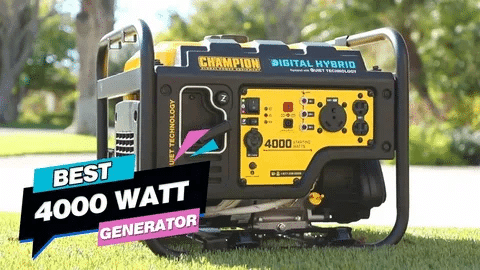Find out the appliances and devices that you can operate using a 4000-watt generator. Find out the difference between running and starting watts and determine power requirements as well as the best tips to make your generator more efficient and safe to operate.
When you need to prepare against power outages, as well as when construction work is done, planning outdoor activities, it is essential to learn what a 4000-watt generator can serve, in order to make right decisions. These instructions take care of maximizing the potential of your generator with due concern of safe and effective use.
Understanding 4000-Watt Generator Basics
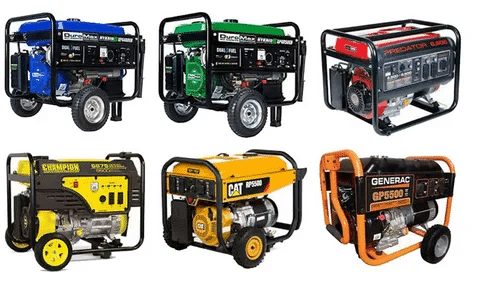
A 4000-watt generator is an all-purpose portable power source which generates 4000 watts (4 kW) of electrical power in the best possible circumstances. These generators are portable power sources and can provide sustained or surge power of up to 4000 watts of electricity and can thus be used in many applications starting with being a back up power supply to working in a job site.
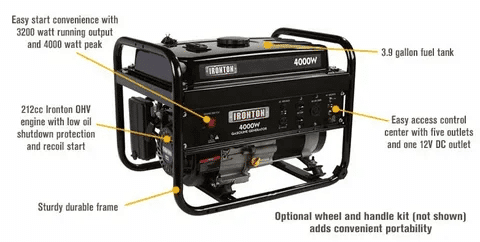
Nevertheless, the 4000-watt generators differ. Usable power is governed by a number of factors such as the type of generator to be used, the fuel to be used and the environment in which the generator is to be operated. This mainly happens because modern inverter generators and solar power stations tend to give more stable performance as opposed to classic ones that use gas.
Running Watts vs Starting Watts: The Critical Difference
Running Watts Explained
Running watts or operating watts is a measure of the constant energy that appliances have to use to stay on after startup. Most of the electrical gadgets such as LED lights, televisions, and laptops only need to have their running wattage to work effectively.
Starting Watts: The Power Surge Factor
Most motors and compressors, in many appliances, need more drawing watts just to start moving (and they consume much more watts to run): usually many times as large as the running watts. This surge power is short lasting and necessary to have correct startup. Examples are becoming common:
- Fridges: 700 W running 2200W starting
- Washing machines: 1200W running / 2300W starting
- Window air conditioners: 1000W continuous, 2000W start:
- Dish washers: 1300W running, 1800W starting
It is important to appreciate this difference since your generator should be able to cover not only the running watts of all appliances you are using but also the starting watts of any device that will turn on.
Essential Appliances a 4000-Watt Generator Can Run
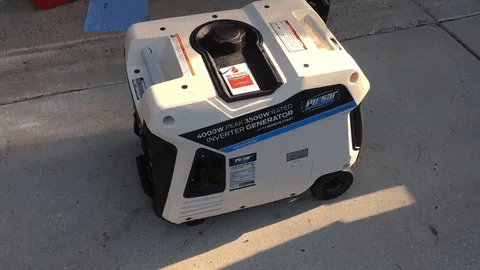
Kitchen Appliances
Refrigerator and Freezer A typical refrigerator consumes 700-800 watts when it is running and up to 2200 watts when starting up. This makes a refrigerator one of the things that can be well run on a 4000-watt generator as a back up in case of emergency since it requires the most watts to start up.
Microwave Ovens Your generic microwave needs 1000-1500 watts, which is not even the upper limit of your generator. Nevertheless, do not use numerous appliances that require much power in your kitchen at the same time.
Coffee Makers and Small Appliances Small appliances Small appliances Such as standard coffee makers (800-1200watt), toasters (800-1500watt) and blenders (300-600watt) will work effectively on a 4000-watt generator.
Heating and Cooling Systems
Space Heaters Electric Space heaters This type of electric heater draws between 1500-2000 watts and will work with 4000- watt generators. But still they take up a good percentage of your power supply.
Window Air Conditioners The 4000-watt generators will work with the Window AC units, but extra care should be taken with the high wattage appliances. A standard window system uses 1000-1500 running watts and 2000-3000 start up watts.
Fans and portable heaters With output of ceiling (75-100W), portable (50-150W) and electric (1000-2000W) fans you should feel chill-free within your power budget.
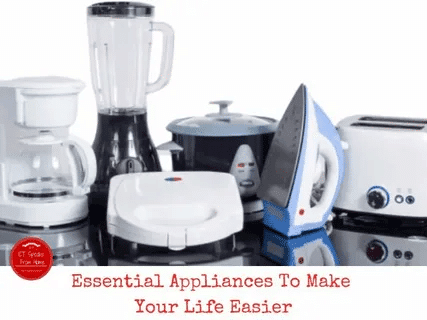
Electronics and Lighting
Entertainment Systems/Televisions New sets of LED TVs use 100-400 watts, whereas older television sets might use more. The watts used by gaming consoles is about 150 to 200 watts.
The LED lights produced by Lighting Systems are super-efficient (the amount of wattage consumed by each bulb is 10-20). You will be able to run the complete LED lighting system of a house with still having spare power to accommodate various other devices.
Computing equipment Laptops (50-100W), desktop computers (300-500W), and networking equipment (50-200W) all make light work of generator capacity.
Household Essentials
Washing Machines washing machines have a 1200 watts sustaining and 2300 watts startup, and therefore can be powered on 4000-watt generators, but take a large part of the available power.
The sump pumps are important devices used in preventing floods in basements and will usually demand 800-1200 watts to run, and 1500-2500 watts to start.
Other medical devices CPAP-machines (30-60W), oxygen concentrators (300-600W), and other medical devices can safely operate on the 4000-watt generators.
What You Cannot Run on a 4000-Watt Generator
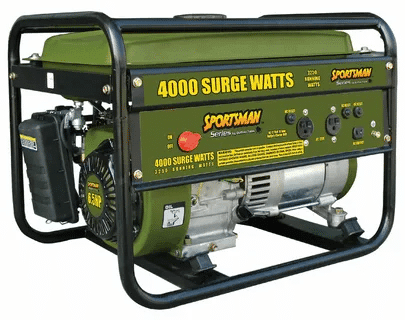
High-Power Appliances to Avoid
Central Air Conditioning Systems Central HVAC systems usually consume 3000-5000 watts of continuous power and 6000-10000 watts to start and this is more than most 4000-watt generators will handle.
Electric Water Heaters These appliances tend to consume 4000-6000 watts, so there is no chance to use better devices.
Electric Stoves and Ovens Volume electric cooking appliances can consume 3000-8000 watts which will not be feasible with 4000- watt generators.
Electric Dryers Appliances such electric dryers of high wattages should be avoided because they normally accommodate 5000-6000 watts.
Power Calculation and Load Management
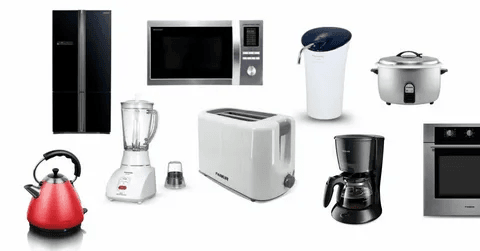
Calculating Your Power Needs
If you want to know whether your appliances will be able to operate:
- Write all the appliances you want to have, along with running and starting watts
- Summate all of running watts of concurrently used gadgets
- Put in the maximum initial wattage not the total initial watts which the appliances do not start together.
- Make sure that does not exceed 4000 watts
Smart Load Management Tips
Essential Provisions in Case of Power Liver in the event of a power outage, isolate essential requirements: refrigerators, illumination, communications equipment and healthcare equipment.
Stagger High-Wattage Startups Never fire up several appliances that rely on electric motors at the same time.
Monitoring Power strips with built-in monitoring smart power strips can be used to monitor power usage and avoid overloads.
Generator Types and Efficiency Considerations
Inverter Generators vs Traditional Generators
Inverter Generators are more consistent and cleaner that can be used with sensitive electronics. They usually provide improved gas mileage and sounder performance.
Traditional Generators Cheaper but they might offer unreliable power quality. Conventional generators are effective in powering basic items and equipments that consume below 4000 watts.
Solar Generators and Power Stations
Solar generators of today have some benefits:
- Silent operation
- Able to use indoors Super-Bright
- Zero emissions
- Stable power generation
- The complete monitoring facilities
Safety Considerations and Best Practices
Installation and Operation Safety
Ventilation Do not use gas generators in buildings or any other confined areas because of risks by carbon monoxide.
Safety Electrical Do not use residential extension cords that are not designed with outdoor use.
Fuel Storage Storing fuel in a cool non-heated area and obeying the manufacturer directions of fuel types.
Maintenance Requirements
Checkups Oil levels, air filters, and fuel systems should be checked regularly to give them an optimum performance.
Routine Maintenance Follow the manufacturer instructions on changes required on the tune- ups and replacement parts.
Professional Applications and Use Cases
Construction and Job Sites
4000-watt generators are useful to builders and contractors to run the necessary tools such as saws, portable lighting and smaller appliances. Typical site-based applications are:
- Circular saws (1200-1800W)
- Hand held hunting (500-1000W)
- Power tools (500-1500W)
- Compressors (1000-2000W)
RV and Camping Applications
With recreational cars, 4000-watts generators are an interesting source of power where one should have got an excellent source of power to:
- Air conditioning units of RVs
- Refrigeration systems
- There is lighting and electronics.
- Systems and water pumps
Emergency Backup Power
With 4000-watts generators, important amenities in the homes can be sustained during power failures:
- Working of refrigerators and freezers
- Essential lighting
- Communication devices
- Medical equipment
- Security systems
Conclusion
A 4000-watt generator delivers a high power output that would suffice in majority applications at home and in workplace. Although it may effectively accommodate critical appliances such as refrigerators, lighting, electronics and numerous power tools, adequate planning and load control is vital to optimum performance. Knowing how to run and start watts, knowing what you should maximize with your generator, and using safety precautions will also assist you in doing your utmost with your generator without jeopardizing your safety.
The recipe of success is the correct planning, appropriate expectations, and realization of your own power needs. Regardless of whether you need your generator as an emergency backup source of power, a job site generator, or a generator to use on the recreational front, a 4000-watt generator is a near perfect way to get the right amount of power and the right amount of portability.

